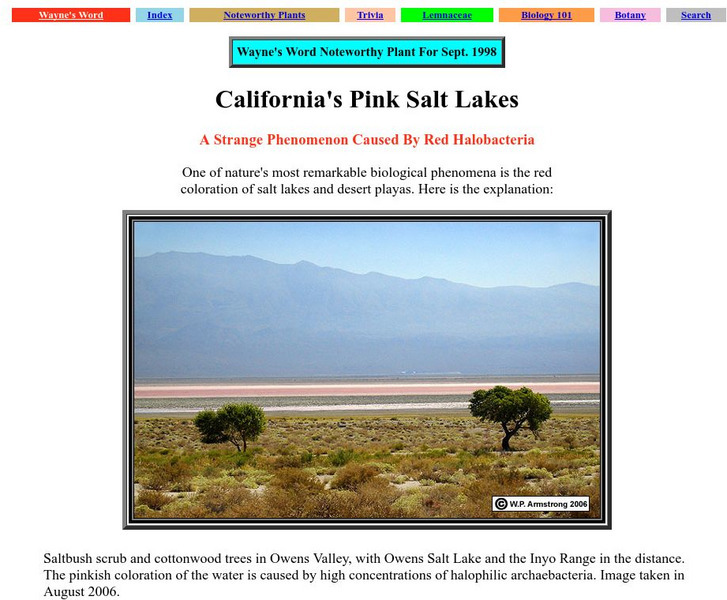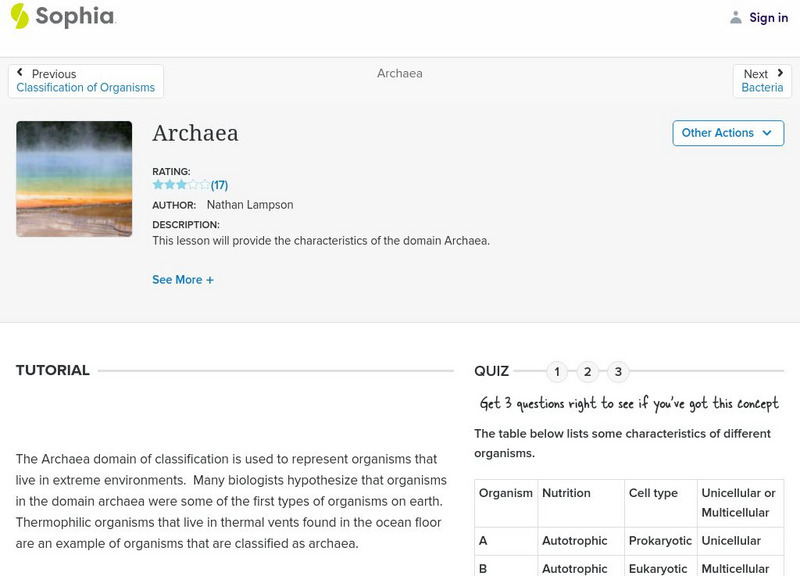University of California
Ucmp: Introduction to the Archaea
Berkley offers an introduction to archaebacteria--ancient bacteria--including the history of the topic, scientific findings, and where to find archaeans. Includes images and links.
Encyclopedia of Earth
Encyclopedia of Earth: Evolutionary Biology: Extremophile
Article describing some of the extreme environments where extremophile organisms can live, and giving examples from bacteria, archaea, flora, and fauna. (Published: November 26, 2010)
Palomar Community College District
Wayne's Word: Life on Salt Lakes
A fascinating report on some of the living things found in salty environments. There are terrific photos of salt flats colored red by some salt loving bacteria.
CK-12 Foundation
Ck 12: Episd: Prokaryote Classification
[Free Registration/Login may be required to access all resource tools.] Students will understand where bacteria live, the different types of prokaryotes, and extremephilic bacteria.
Untamed Science
Untamed Science: Biology: Evolution: History of Life: Origins
Learn about the scientific hypotheses of the origin of life on Earth. [5:55]
City University of New York
Brooklyn College: The World of Cells: Prokaryotic Cells
A very nice introduction to this group organized in a concise, easy to follow format.
Estrella Mountain Community College
Online Biology Book: Biological Diversity: Bacteria and Archaeans
In this online biology textbook, learn about the two prokaryotic domains of life, which include eubacteria and acrhaebacteria.
CK-12 Foundation
Ck 12: Life Science: Archaea
[Free Registration/Login may be required to access all resource tools.] For many years, archaea were classified as bacteria. Like the bacteria, archaea lacked a nucleus and membrane-bound organelles and, therefore, were prokaryotic...
CK-12 Foundation
Ck 12: Life Science: Types of Archaea
[Free Registration/Login may be required to access all resource tools.] The first archaea described could survive in extremely harsh environments in which no other organisms could survive. As a result, archaea are often distinguished by...
BiologyWise
Biology Wise: Archaebacteria Kingdom
Describes the characteristics of archaebacteria, the different subgroups, and the importance of archaebacteria.
Woods Hole Oceanographic Institution
Woods Hole Oceanography Institute: Bacteria at Hydrothermal Vents
Discover more about the thermophiles (bacteria) that live in hydrothermal vents ranging from the ocean floor to Yellowstone hotsprings.
CK-12 Foundation
Ck 12: Life Science: 5.7 Types of Archaea
Explore the diversity of the domain Archaea.
CK-12 Foundation
Ck 12: Life Science: 5.6 Archaea
Understand what characteristics make up organisms in the Archaea domain.
PBS
Nova: The Lives of Extremophiles
An interview with a microbiologist who studies bacteria that decompose hydrogen sulfide gas and other noxious chemicals. The interview focuses on her research and her career.
BiologyWise
Biology Wise: Archaebacteria Examples
Presents the characteristics of archaebacteria and a list of examples from each of the three main subgroups.
BiologyWise
Biology Wise: Archaebacteria and Eubacteria Difference
Explains what archaebacteria and eubacteria are and presents a chart showing how they differ in structure and characteristics.
BiologyWise
Biology Wise: Characteristics of Archaebacteria
Explains what archaebacteria are, the different phyla, and the characteristics of archaebacteria.
Other
Secondary Science Program: The Six Kingdoms
A short overview of the six kingdoms in our scientific classification system: Plants, Animals, Protists, Fungi, Archaebacteria, and Eubacteria.













